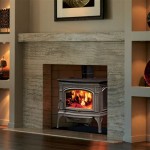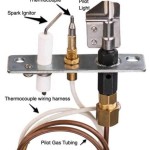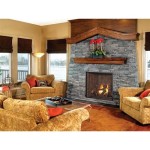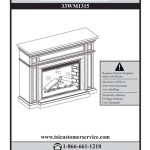Navigating the World of Old Fireplace Parts: Identification, Sourcing, and Preservation
Fireplaces, historically central to domestic life, evolved from simple hearths to elaborate architectural features. Many older homes retain these fireplaces, offering not only aesthetic appeal but also a tangible link to the past. However, maintaining and restoring these fireplaces often necessitates locating specific replacement parts, a task complicated by the passage of time and the discontinuation of manufacturing. Successfully navigating the world of old fireplace parts requires a comprehensive understanding of identification methods, sourcing strategies, and preservation techniques.
Identifying Old Fireplace Parts
Accurate identification is the first and most critical step in acquiring the correct replacement part. This process involves a multifaceted approach, considering material composition, style, manufacturer markings, and dimensions. Misidentification can lead to compatibility issues, potentially compromising the fireplace's functionality and safety.
Material composition provides initial clues. Fireplace parts were historically constructed from various materials, including cast iron, wrought iron, steel, brass, and even soapstone. Cast iron grates, for instance, are readily identifiable by their characteristic weight, rough texture, and potential signs of rust. Brass andirons, known for their decorative appeal, usually exhibit a distinct golden hue and can sometimes be tarnished or pitted with age. The material's density, texture, and reaction to cleaning agents can all contribute to accurate material identification.
Stylistic features offer further insights. Fireplace designs have evolved significantly over time, reflecting prevailing architectural trends. Art Deco fireplaces from the 1920s and 1930s, for example, often incorporate geometric patterns and streamlined forms. Victorian-era fireplaces, in contrast, are usually characterized by ornate detailing, intricate carvings, and often feature floral or scroll motifs. Recognizing the stylistic period of the fireplace can help narrow down the search for compatible parts.
Manufacturer markings, when present, are invaluable. Many fireplace manufacturers stamped their parts with identifying marks, including company names, logos, or part numbers. These markings are often found on the back or underside of parts, requiring careful inspection. Resources like historical trade catalogs, online archives, and specialized fireplace part databases can assist in deciphering these markings and tracing the part back to its original manufacturer.
Dimensional accuracy is paramount. Even if a part appears visually similar, slight differences in dimensions can render it incompatible. Precise measurements of the existing part, including length, width, height, and diameter (for circular components), are essential. A digital caliper is a useful tool for obtaining accurate measurements, particularly for intricate components with complex geometries. These measurements should be meticulously recorded and used as a reference when searching for replacements.
Sourcing Strategies for Old Fireplace Parts
Once a part has been accurately identified, the next challenge lies in sourcing a suitable replacement. Several avenues exist for locating old fireplace parts, each with its own advantages and disadvantages. These include antique stores, salvage yards, online marketplaces, and custom fabrication.
Antique stores and architectural salvage yards offer a physical browsing experience. These venues often house a diverse collection of reclaimed architectural elements, including fireplace parts. Visiting these establishments allows for hands-on inspection, enabling assessment of the part's condition and compatibility. However, availability can be unpredictable, and prices may be higher than other sources.
Online marketplaces, such as eBay, Etsy, and specialized antique websites, provide a wider reach. These platforms connect buyers and sellers from across the country or even internationally. Search filters can be employed to refine the search based on part type, material, style, and dimensions. However, online purchases necessitate relying on photographs and descriptions, increasing the risk of misrepresentation. Thoroughly scrutinizing the seller's reputation and requesting additional photos are crucial steps before committing to a purchase.
Custom fabrication offers a solution when a direct replacement cannot be found. Skilled blacksmiths, metalworkers, and foundries can replicate damaged or missing parts based on existing examples or detailed drawings. This approach ensures perfect compatibility but can be more expensive and time-consuming compared to sourcing existing parts. It is crucial to select a fabricator with experience in historical restoration and a commitment to preserving the original design intent.
Networking with other enthusiasts and restoration professionals can yield valuable leads. Local historical societies, vintage home forums, and fireplace restoration companies often possess specialized knowledge and access to resources that are not readily available to the general public. Attending workshops and conferences related to historic preservation can also facilitate networking and information sharing.
Preservation Techniques for Old Fireplace Parts
Acquiring an old fireplace part is only the first step; proper preservation is crucial to ensuring its longevity and maintaining its historical integrity. Preservation techniques vary depending on the material and condition of the part, but generally involve cleaning, rust removal, repair, and protective coatings.
Cleaning removes accumulated dirt, soot, and grime. The approach to cleaning depends on the material. For cast iron, a wire brush or gentle abrasive pad can be used to remove loose rust and debris. Brass parts can be cleaned with specialized brass cleaners that effectively remove tarnish without damaging the underlying metal. Avoid using harsh chemicals or abrasive cleaners on delicate surfaces, as they can cause irreversible damage.
Rust removal is essential for preventing further deterioration of iron and steel parts. Mechanical methods, such as wire brushing or sanding, can be effective for removing surface rust. Chemical rust removers, which contain acids or chelating agents, can be used for more stubborn rust deposits. After rust removal, it is crucial to neutralize any remaining chemical residue and apply a protective coating to prevent future corrosion.
Repairing cracks and breaks restores structural integrity. Minor cracks in cast iron can sometimes be repaired using specialized epoxy resins or metal fillers. However, for more significant damage, welding or brazing may be required. It is essential to consult with a qualified metalworker when undertaking repairs, as improper techniques can weaken the part and compromise its safety. Broken or missing decorative elements can often be replicated using molding and casting techniques.
Protective coatings prevent future deterioration. For iron and steel parts, a coat of high-temperature paint or a protective oil finish can help prevent rust. Brass parts can be protected with a clear lacquer or wax coating to prevent tarnishing. When selecting a protective coating, it is important to consider its compatibility with the material and its ability to withstand the high temperatures associated with fireplace use. Regularly inspecting and maintaining the protective coating is crucial for long-term preservation.
Storage conditions play a vital role in preservation. When parts are not in use, they should be stored in a dry, well-ventilated environment. Avoid storing metal parts in damp or humid conditions, as this will accelerate corrosion. Wrapping parts in acid-free paper or cloth can provide additional protection against dust and scratches.
Ultimately, the successful acquisition and preservation of old fireplace parts requires a combination of knowledge, patience, and attention to detail. By understanding the principles of identification, sourcing, and preservation, it is possible to maintain and restore these historical features, ensuring that they continue to provide warmth, beauty, and a connection to the past for generations to come.

What Are The Components Of A Fireplace Five Ways Fires

Vl21ng Vl21lp Old Majestic The Cozy Cabin Stove Fireplace Parts

Aspen Wood Stove 1920 The Cozy Cabin Fireplace Parts

Gbu36 Natural Vent Gas Fireplace 232 234 Vermontcastings Parts For Vermont Castings Majestic

Vint I Ia Vermontcastings Parts For Vermont Castings Majestic

Chimney Diagram Potomac Services

Wm R 36 Wm36a Wmii42 A Ht Wm42sx Series Fireplaces 30 31 79 82 106 111 112152 153 235 236 306 Wm36 The Cozy Cabin Stove Fireplace Parts

Gas Fireplace Natural Bdm35 The Cozy Cabin Lennox Hearth Parts

Update Your Heatilator Mark 123 Fireplace In No Time

Ewf30 Wfe05h0 The Cozy Cabin Stove Fireplace Parts
Related Posts








